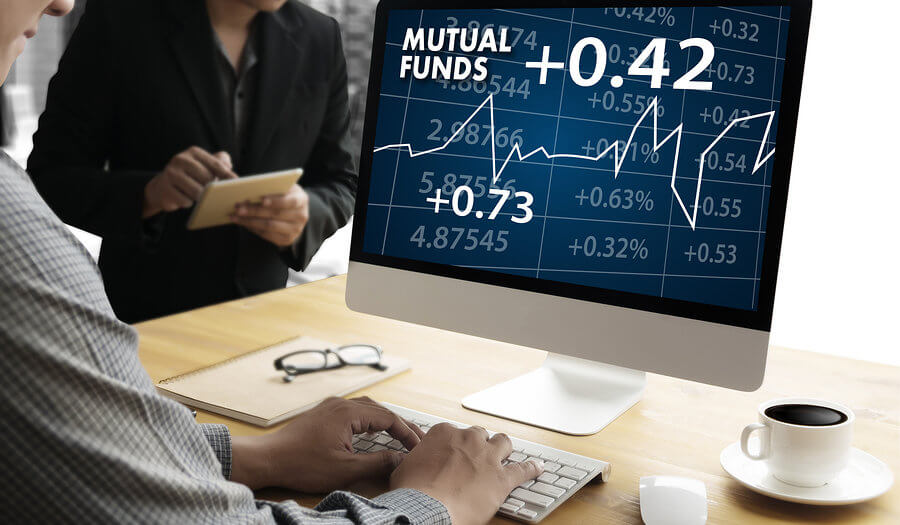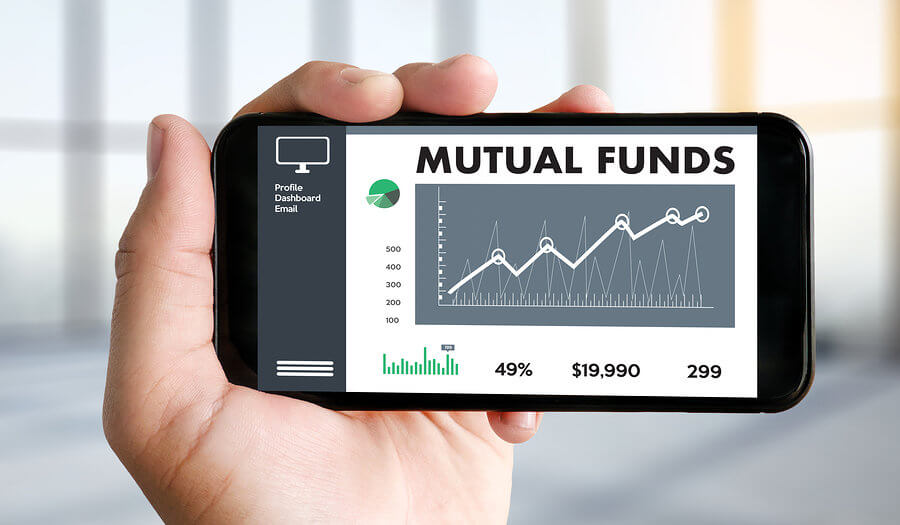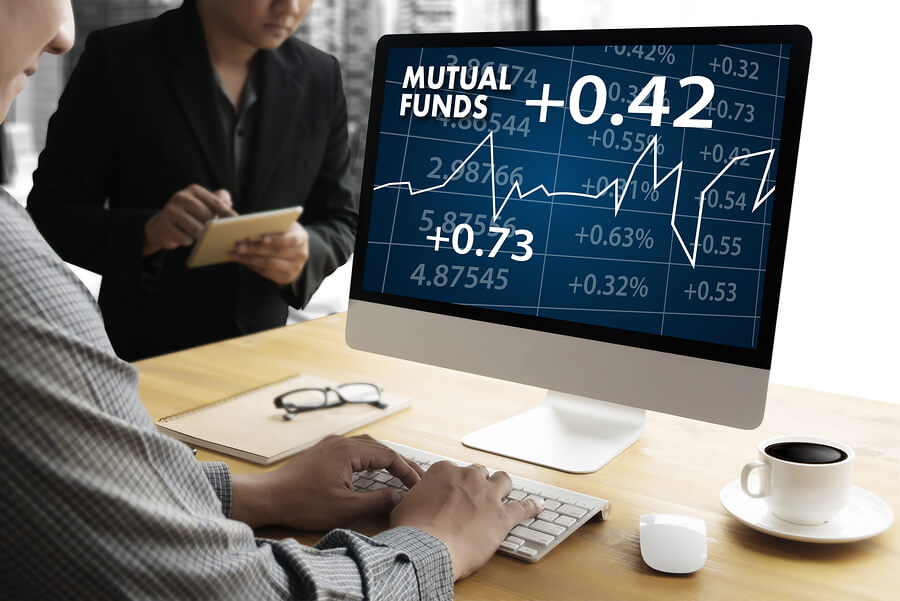Last Updated on January 11, 2023 by pf team
With a mutual fund, you can invest in stocks, bonds, or securities, or even a mix of asset types. There’s a mutual fund for just about any interest, sector, or risk tolerance. Here’s what you’ll want to consider before choosing a fund.
Mutual funds offer a way to build wealth without having to be an expert stock picker. But mutual funds aren’t only for investing in the stock market.

In this article :
What is a mutual fund?
A mutual fund is a type of pooled investment. Investors in the fund can benefit from having a fund manager to choose investments and choose investment levels, while all owners of the fund share in the success of the investments.
Much like stocks, mutual funds are sold as shares but depending on the type of mutual fund, the amount of shares might change based on demand or the number of shares might remain constant.
With a mutual fund, you’re buying shares in the fund itself. The fund then buys shares of other companies or makes other investments.
Some of the money held by a mutual fund might even be held in cash, waiting for a buying opportunity, or be invested in short-term interest-bearing investments.
A mutual fund lets you diversify your investments without having to build your own safety strategy. The fund’s expert management team can keep a close eye on the market, including news or trends that can affect the fund’s investments.
Doing all this on your own would be difficult for investors. This convenience has made mutual funds a popular choice since their introduction in the 1920’s.
Service comes at a price, however, and mutual fund management isn’t free. Funds charge a management fee, which can reduce investment returns.
Depending on the type of fund you choose, fees can range from a fraction of a percent to over 2% and pay for the fund’s expenses, including trading costs.
Actively-managed mutual funds charge an average of about 1.5% and many funds, such as passively-managed funds, have much lower fees.
How does a mutual fund work?
A mutual fund lets investors pool their money for the mutual benefit of all the fund’s investors, but there’s a bit more to how mutual funds work.
There are several types of mutual funds. While they all work off the same structure of pooled investments, the way they perform in that role differs.
Open-end funds
The easiest way to understand open-end funds is to think of the fund as an investment pool that expands and contracts its number of shares based on demand. The number of shares in an open-end fund changes based on the number of investors.
New shares are created for new investors to the fund and as shares are sold, the number of shares is reduced. In most cases, shares in open-end funds aren’t tradeable.
You can buy shares in the fund or sell shares directly through the mutual fund provider, but you can’t trade shares on a stock exchange. The pricing for shares is based on the fund’s net asset value (NAV), which is like a net worth statement.
A fund’s NAV represents the value of assets in the fund minus its liabilities, such as money the fund has borrowed. This number is then divided by the number of shares in the fund to determine the share price.
The NAV is calculated at the end of the trading day, which means if you are buying or selling shares, you may not know the exact price of the shares at the time you buy or sell in an open-end fund.
Open-end funds are the most common type of mutual fund, with a large part of their success due to open-end funds being common in 401k and other retirement plans.
Exchange-traded funds (ETFs) are a well-known type of open-end fund that expands the number of shares to meet demand. However, unlike many other open-end funds, ETFs are traded on stock market exchanges.
A special share creation/redemption process makes ETFs unique among open-end funds and easily tradeable.
Closed-end funds
A closed-end fund is a fund with a fixed number of shares. At the fund’s initial purchase offering (IPO), a fixed number of shares are available for purchase. After these shares are bought by investors, the shares can be traded on stock exchanges, which makes closed end funds easy to buy or sell.
A big difference for closed-end funds when compared to open-end funds is that closed end funds are priced by the market of buyers and sellers. Rather than the fund setting the price based on NAV, the price is determined by market demand — or lack thereof — and the price of shares can differ from NAV.
The difference in share price compared to NAV can create another way to profit from shares, assuming the price disparity is temporary. In a closed-end fund, the fund doesn’t have to sell assets or reduce cash if someone sells shares in the fund.
The shares are bought and sold amongst investors on exchanges and the fund is unaffected by purchases or sales after the IPO. Closed end funds often borrow money to leverage investments. Borrowing can enhance returns but can also reduce NAV. Open-end funds are less likely to borrow.
Unit investment trusts
A unit investment trust (UIT) is in the same family as mutual funds. In fact, some ETFs are structured as unit investment trusts. One big difference compared to most mutual funds is that a unit investment trust seldom changes its holdings.
The trust usually holds its investments until the termination date for the fund. When the termination date is reached, the trust sells its holdings and distributes the proceeds to its investors.
Instead of shares, investors purchase units in the trust. Units are limited in number, however, much like shares in a closed-end fund. Some UIT sponsors provide a secondary market for trading amongst trust owners. Units in the trust can be redeemed prior to the termination ate at the net asset value of the units.
Think of a unit investment trust as a focused investment. The value of the units change but the investments held by the trust usually don’t change. UITs are popular with some investors because of their transparency.
Exchange-traded funds
Mutual funds already had nearly 70 years of history when exchange-traded funds (ETFs) came onto the scene in the early 90’s. Part of the attraction to traditional stocks is their liquidity. It’s usually very easy to sell a stock if needed or to build a position according to your own schedule and budget.
ETFs offer the same kind of liquidity you’ll find with most stocks because they are traded on stock exchanges. In regard to trading, ETFs are like closed-end funds. One big difference however is how shares in an ETF are handled.
Shares are created and redeemed as needed to meet demand in what’s called the “creation/redemption” mechanism. The process can be complex behind the scenes but is seamless to investors and allows a free market for ETFs without the high fees found in other types of mutual funds.
The most commonly known ETFs are index funds, which track a particular stock index, like the S&P 500 or the Dow Jones Industrial Average. As ETFs have evolved, however, you can now find ETFs that target nearly any investment sector that interests you.
Want to buy gold without having to store bullion? There’s an ETF to track gold. In fact, there are several well-respected gold ETFs. Interested in cryptocurrency but don’t want to mine coins? There are ETFs for crypto investors too.
ETFs offer a low-cost way to invest in sectors or indexes while still providing ample liquidity and easy trading access.

Pros of a mutual fund
Mutual funds offer some great advantages. A team of experts choose investments for the fund, which makes investing easy for you. Mutual funds also help you to diversify because the fund owns many assets.
These are just some of the reasons mutual funds are a common choice in retirement plans.
- Safety: Owning just one stock can be risky. Mutual funds usually buy many types of stocks, often in varied sectors.
- Managed investments: Imagine having your rich uncle who knows all about stocks helping you put together a portfolio. But what do you do after your uncle goes back home? Mutual funds have managers or management teams that do the research for you and understand when to buy or sell.
- Reinvestment: Many mutual funds pay dividends. In most cases, you can set up your account to reinvest dividends. Later, the shares purchased with dividends will earn dividends as well. The money can start piling up quickly.
- Range of options: Today’s mutual fund options let you choose funds that follow nearly any interest. You can also choose funds that track a broad index, or even the entire stock market.
Cons of a mutual fund
Mutual funds may not be the right choice in every situation. Fees can take a bite out of earnings. Earnings can also suffer from taxes and cash that’s held aside for redemptions.
- Limited investment options: Owning a mutual fund can seem like being in the passenger seat. If the fund is going in a different direction than you prefer, your only choices are to ride it out or sell your shares. Fortunately, you can own more than one fund if you choose.
- Fees: Mutual funds get a bad rap for fees, and some of it may be deserved. Fees can take a big bite out of long-term earnings, so it’s important to weigh the value of the fund. Are the fees worth paying? For better returns or more safety, the fees charged may be worthwhile. In other cases, fees are just fees and can hurt your investment performance.
- Efficiency: Many mutual funds have low operating costs. However, funds may need to keep cash available for people who want to sell their shares. This means not all of your investment is being put to work. Some experts estimate the cost of maintaining this liquidity at nearly 1%.
- Over-diversification: Some mutual funds own over 200 stocks. That’s a lot to keep track of, but holding so many stocks can also limit returns. You might prefer a more focused approach.
Types of mutual funds
Not only can you choose from mutual funds that have a focus on a specific type of company, but you can also choose funds that have a growth or risk management objective.
Here are some of the types of mutual funds available.
- Growth: A growth fund is focused on stock appreciation, which in turn drives the NAV and share value for fund shares. The stocks the fund owns are stocks that are expected to grow significantly. However, growth funds aren’t always limited to startups. In many cases, established companies can be growth stocks as well, particularly if they are reinvesting their earnings or expanding.
- Income: An income fund is focused on earnings from interest or dividends. Bonds and other fixed-income assets are common investments for income funds. Stocks that pay a strong dividend may also be part of the portfolio.
- Growth and income: Some funds target both asset appreciation and income. You might also see these funds referred to as value funds. Often growth and income funds target stocks that are priced low based on earnings or other value fundamentals.
- Equity/stock: An equity or stock mutual fund is a fund focused on stocks. Stock mutual funds can be broad or specialized, such as a fund that only holds only energy stocks.
- Bond funds: Bond mutual funds are exactly what they sound like. The fund invests in bonds and pays dividends that are based on interest earned from the bonds as well as appreciation in the value of the bonds.
- Balanced: A balanced mutual fund seeks safe returns through diversification. The fund may hold various kinds of investments, including stocks, bonds. A money market component may be part of the fund as well. The fund’s assets are split between stocks and interest-bearing vehicles with a goal of finding a balance between growth and income.
- Money market mutual fund (MMMF): A money market fund invests in cash and high-quality debt that has a short-term maturity. This ensures that money market accounts are nimble and liquid. Investors are paid a dividend based on interest earned from the fund’s assets.
- Sector: Mutual funds can specialize in stocks within a given sector. For example, a fund might focus on tech stocks, oil stocks, or retailers. With ETFs as an option, you can invest in any sector without having to guess which individual stocks within the sector will perform well.
- Index: If you’ve heard of the S&P 500, Nasdaq, Russell 2000, or the Dow, you’re familiar with an index. With index funds, the fund tracks the index rather than trying to outperform the market. Indexes can be broad, like the S&P, or more narrowly focused.
- International funds: With international mutual funds, you’ll find an easy way to invest across borders. International funds may buy stocks from certain countries. Other funds buy stocks from a region. Some funds also buy groups of stocks that have similar traits or growth prospects.

How do you make money with a mutual fund?
Depending on the type of mutual fund you choose, there can be 3 different ways to make money with your investment. Two of these ways to make money can work hand in hand. The third is through dividends, which are a return of earnings from the fund.
1. Dividends
Mutual funds are required to pass on their net income to shareholders. The fund’s income includes interest payments if the fund owns bonds or notes. Income also includes dividend payments from the stocks the fund owns. These earnings are paid to fund owners as a dividend distribution.
Many well-known companies pay a dividend, which is a share of the company’s earnings. A fund might own hundreds of stocks, some of which pay dividends. It might also own several types of bonds or interest-bearing assets. This means the dividend distribution amount varies from year to year.
Mutual funds have to pay distributions to shareholders at least once per year if the fund has earnings. Often, distributions are paid at the end of the year. However, fund can pay earnings quarterly or even monthly.
More frequent payments are common for income funds. These funds often pay monthly dividends. Income funds are popular with investors who want passive income. Some investors prefer to reinvest dividends to buy more shares. These new shares can then earn more dividends.
Most funds allow you to reinvest automatically. The choice is yours. It’s important to know that dividend distributions from mutual funds are taxable unless the mutual fund is in a qualified account, such as a 401k or IRA.
2. Capital gains
If you buy mutual fund shares at $50 per share and the shares increase in value to $75 per share, that’s a capital gain. Think of the initial investment as capital and the increase as the gain. The share price of most mutual funds increases over time.
This is because the assets owned by the fund are increasing in value. Of course, there are no guarantees in investing. The value of the fund’s holdings can go down as well.
If you take a long view, however, it’s likely that your fund shares will increase in value over time. Often, the increase over time can be dramatic. Not all mutual funds benefit from capital gains, however. For example, money market funds are designed to maintain a net asset value of $1 per share.
These funds are designed for income and safety rather than capital gains. Capital gains from share price increases are taxable, but only when you sell your shares.
There may be a different tax liability from capital gains, however. If your fund sells a stock for a profit, the profit is given back to shareholders as a distribution.
The distribution is taxable. The silver lining is that the distribution is often taxed as long-term capital gains, which is a lower tax rate. This is because the mutual fund probably owned the shares for more than a year.
3. Net asset value (NAV)
Earlier we discussed net asset value and how it’s calculated. For a open-end fund the share price equals the NAV. For closed-end funds, there can be a difference between the NAV and the share price. Sometimes, the difference in price can be significant.
For example, a closed-end fund might have a NAV of $50. This means the fund’s assets minus its liabilities gives each share a value of $50.
However, a closed-end fund might be trading at $45 per share. Remember, closed-end funds trade on exchanges and the market determines the price. Markets aren’t always as efficient and there can be buying opportunities where shares are priced below the value of the fund.
When this happens, the fund is said to be trading at a discount. The opposite can happen as well, with funds trading above the NAV. This is called trading at a premium.
Whether trading at a premium or at a discount, a spread between the NAV and the share price can mean a few things. A fund trading at a discount might be temporary. Warren Buffet made his fortune by finding stocks that the market mispriced.
Closed-end mutual funds can offer a similar opportunity. However, it’s also possible that the fund is trading at a discount because investors feel less confident in the fund’s holdings or its management.
This same sentiment is likely the reason that funds trade at a premium to NAV. Investors may feel confident in the prospects of the fund and are willing to pay a bit more to buy shares.
If you find a fund that’s trading at a discount, there may be an opportunity to boost your gains. It may also be a sign of caution. Either way, investment requires due diligence and benefits from a bit of research.
How to invest in mutual funds

The type of account you’re investing in can make a big difference when choosing a mutual fund.
Traditional mutual funds can be a better fit for a tax-deferred account, like a 401k or IRA. ETFs can be a great way to go if you have a taxable investment account.
The type of account you’re using for investments can play a role but your investment priorities are unique to you and there are times when the type of account is a secondary consideration.
Retirement accounts
IRA accounts, 401k accounts and other qualified retirement accounts can be a great choice when investing with mutual funds.
Because these accounts are tax-deferred, the taxable events that occur with mutual funds aren't a concern and don't slow the growth of your investment.
Online discount brokerages
Online brokerages have come a long way. Modern discount brokers now offer a wide selection of mutual funds and exchange traded funds.
In many cases, exchange-traded funds can be traded without commission charges. Closed-end funds can be traded on supported exchanges.
Online brokers offer both IRA accounts and traditional accounts. You’ll find all the tools you need to make a researched decision and can easily compare funds.
Mutual fund providers
You can also buy mutual funds direct from the mutual fund company. For example, Vanguard is a well-known fund company that sells direct to investors.
Vanguard also sells mutual funds through some brokers. There’s no price advantage to buying a fund directly. It’s a matter of preference.
Robo-advisors
A robo-advisor can help choose the right investments to meet a financial goal. Most robo advisors build a portfolio using ETFs and low-cost index funds.
However, some robo-advisors also include actively-managed funds. For a hands-off investment strategy, a robo-advisor can be the right tool for the job.
Mutual funds investing ideas
Short-term returns can be attractive, but you’ll want to dig a bit deeper. For growth, look for funds with a solid track record of performance. Below, we’ll compare some top performing stock funds and how they compare over time.
- Morgan Stanley Multi Cap Growth A (CPOAX)
- Fidelity Advisor Growth Opportunities A (FAGAX)
- Fidelity Advisor Growth Opportunities A (MSEGX)
- Shelton Capital Nasdaq-100 Index Direct (NASDX)
- USAA Nasdaq-100 Index (USNQX)
Here’s how a $10,000 investment would have grown based on each fund’s actual performance.
| $10000 invested | 1 year | 3 years | 5 years | 10 years |
| CPOAX | $11,193 | $20,878 | $22,790 | $55,274 |
| FAGAX | $11,289 | $19,386 | $21,303 | $53,007 |
| MSEGX | $10,175 | $17,909 | $20,421 | $51,545 |
| NASDX | $10,172 | $16,020 | $19,060 | $49,991 |
| USNQX | $10,116 | $16,413 | $19,449 | $49,737 |
Headline returns can be attractive but you also have to consider fees. For example, a fund with a 5% front-end load reduces the amount you can invest to $9,500. That can hurt long-term earnings.
Management fees can be costly as well. Most of the funds above have an expense ratio of less than 1%. Many other funds have higher expense ratios, however. It’s important to weigh all the details before choosing a fund.
Fees associated with mutual funds investing
Mutual funds fees aren’t always immediately obvious and can put a dent in earnings over time. In some cases, higher fees may be justified. Other times, various fees are black holes that can change your investment trajectory.
Expense ratio (net and gross)
Mutual fund management isn’t free. The expense ratio offers a way to compare the internal costs of running the fund. Three types of fees make up a fund’s expense ratio, which is a percentage of the fund’s assets.
- Management fees
- Administrative fees
- Advertising fees
These fees make up the gross expense ratio. Sometimes funds offer waivers that reduce certain fees, perhaps for a limited time. The adjusted percentage is called the net expense ratio. Think of a net expense ratio as promotion that may not last.
Sales charge or load
A sales charge or load is a commission paid to the broker. Funds can have a front-end load or a back-end load. Sales charges can be more costly than they might seem. A front-end load reduces the amount you invest, also reducing the amount you can earn.
A back-end load works almost like a tax, reducing the net amount of money you have when you sell your shares. Not all funds have sales loads. Be sure to shop around.
12b-1 fees
Many funds charge a marketing fee as well, called a 12b-1 fee. This fee is included in the expense ratio but it can be helpful to understand how much you are paying for advertising.
Transaction fees
When you buy a mutual fund through a broker, even if there is no load, there may be transaction fees. A transaction fee is a trading fee, much like the trading fees for buying and selling stocks.
Mutual funds FAQs

How do I choose mutual funds?
The first step in choosing a fund is to know your goal. An income investor would choose a different fund than a growth investor. Mutual fund providers offer information on the goals of the fund. Details like performance, yield, and expenses are also important to consider.
How do I buy direct mutual funds?
Think of a direct fund as a fund with no middleman. Many mutual fund companies offer ways to invest directly online or by phone. Vanguard, for example, is the largest mutual fund provider and offers direct funds. With a direct fund, expenses are often lower.
What is an actively managed mutual fund?
An actively managed fund uses a manager or team to make investment decisions. The management team decides which assets to buy or sell and determines the best time to trade. The team may also decide to borrow money, depending on the type of fund.
What is a passively managed mutual fund?
A passively managed fund doesn’t have a fund manager to make buying or selling decisions. Instead, passive funds use software to buy or sell assets in line with the fund’s goals. Passive funds usually track an index or group of stocks. Many ETFs and index funds are passively managed.
How much money should I invest in mutual funds?
Mutual funds are naturally diversified but it’s often a good idea to hold money in other assets as well. It’s also wise to keep some money in liquid investments. Most mutual funds have a minimum initial investment which can be between $500 and $3,000. This can be something to consider when choosing an investment amount.
Can you withdraw money from a mutual fund?
Yes, you can withdraw money from a mutual fund. However, it’s important to understand the tax treatment of account withdrawals. If you have a retirement accounts, withdrawals can carry tax penalties and may be taxed as income.
What's the average return on mutual funds?
It isn’t unusual for mutual funds to earn 8% to 10% annually, but this is higher than the norm. Mutual funds can be bond funds or money market funds. Because these types of funds have lower average returns, the overall average for mutual funds is lower than the broad stock market.
What is the least risky type of mutual fund?
Bond funds offer the lowest risk to capital. These funds are designed for income and safety but don’t have the same growth opportunities as stock funds or balanced funds. Money market funds are also low risk.
Which fund has the highest risk?
High risk funds can be either stock funds or high-yield funds. The latter invests in lower quality debt that pays a high interest rate. Some international funds are also high risk.
Can you lose all your money in a mutual fund?
Because mutual funds are diversified, it’s difficult to lose all your money. Every asset in the fund would have to go to zero for the shares to become worthless, which is unlikely. Short-term losses are possible, however.
Summary
Mutual funds can be a great way to build wealth or generate passive income. You’ll have to choose the right kind of fund for your investment goals, though.
Management expenses and taxes can take a big bite out of earnings. Look for funds that have a lower expense ratio to help maximize your returns.
If you’re investing in a taxable account, consider using ETFs as well to help reduce the periodic taxes that can impact long-term growth.
